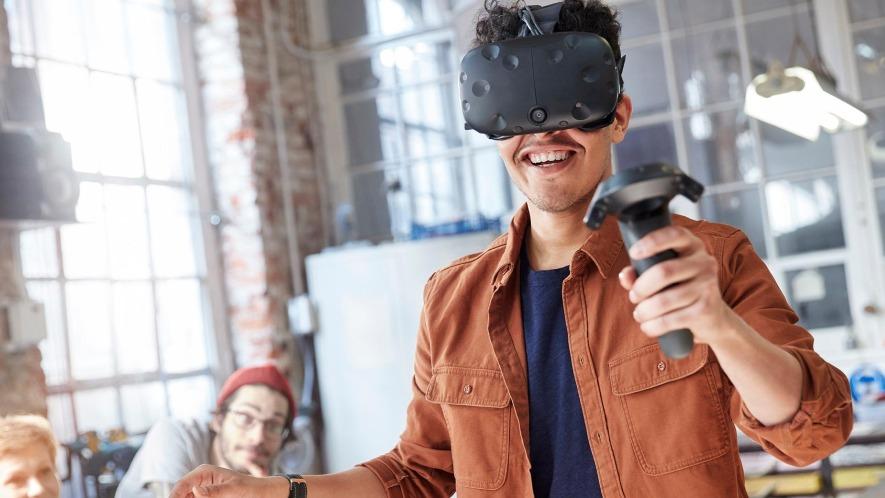{{item.title}}

Key takeaways
Time for a reality check: if you’ve been sidelining forms of computer-enhanced reality, or dismiss it as a marketing gimmick, you could miss out on the transformative applications the technology promises to business.
There are many acronyms flying around this space, but extended reality (XR) is the umbrella term which covers all forms of combined real-and-virtual environments, including augmented reality (AR), virtual reality (VR) and mixed reality (MR). In essence, XR covers the spectrum of the technology that spans from simple, digital overlays through to fully immersive digital experiences.
It also represents the next level of what we call the Essential Eight technologies: it is through combining AR and VR with artificial intelligence and the Internet of Things that its true power can be unlocked.
What once may have been a technology synonymous with serious gaming, forms of XR have hit the mainstream in a big way. Perhaps in part due to the phenomenal popularity of AR smartphone game app Pokémon Go, which took the world by storm in 2016, revenue for the global VR market hit a breakthrough in 2017, soaring over 350% to US$3.9 billion, according to PwC’s Entertainment and Media Outlook.
It’s not stopping there. According to market research firm Statista, the VR and AR market will be worth US$209 billion by 2022,1 while forecasts by market intelligence firm IDC show that worldwide shipments of AR and VR headsets will reach 65.9 million units by that same year.2
The impact of this technology cannot be understated: it promises to change the way we buy things, learn things, and do things. It will intersect with almost every industry and provide value to both consumers and the enterprise.
What is so powerful about extended reality is its ability to stretch, bend and reshape conventional ways of doing things. Consider virtual reality, which can assist workers in assembling and repairing jet engines, help architects envision what a retail space will look like before they even break ground, and allow consumers to view and experience products — everything from furniture to automobiles — all without leaving home.
Using a head-mounted display, it’s possible to see, hear, learn and explore the world as never before. Rather than enduring yet another boring slide presentation, imagine watching an ultra-realistic presentation in 3D. Or learning in an immersive and dynamic way, rather than wading through a tedious manual.
The value of this technology is clear: a company that we worked with recently trained up 2,800 people in just three days by using spatial audio and 360-degree video to transport attendees to a virtual meeting space. Meanwhile, at an insurance company, VR-trained users demonstrated a 90% improvement in job skills accuracy and an 89% improvement in business process execution accuracy compared with the users who were not trained with VR.
Another technology providing business value is augmented reality, which creates a synthetic visual overlay by using smart glasses — or a medium such as an automobile windshield — to project information over a view of the physical environment. For instance, while repairing a machine, a technician might view instructions, specifications or a video on their smart glasses, eliminating the need for an instruction manual. Consumers too could use a smartphone to view a piece of furniture exactly as it would look in their home. In a commercial application, specialists on a hazardous materials team might use AR glasses or their vehicle’s windshield to view data about toxic substances before entering a dangerous area.
In addition, AR and VR can be combined to create intriguing possibilities. For instance, mixed reality could enable people to meet virtually in a collaborative workspace and view physical objects, such as a prototype of a proposed new product or a kiosk at a trade show. It also could allow an engineer to enter a building that’s under construction and see what the wiring or plumbing will look like once it’s completed.
XR unlocks business opportunities that previously could not be achieved in a cost-effective way. For example, XR enables remote collaboration with field service technicians, delivers interactive experiential marketing to consumers, and changes how businesses are using simulation-based training and product development.
It’s clear that exended reality has established a foothold in enterprise, and we expect this technology to create numerous opportunities for businesses that get it right. These include identifying additional revenue streams, building new business models, and boosting customer satisfaction and retention.
In order for this technology’s potential to be fully unleashed, a seamless hardware and software ecosystem is needed, which will significantly enhance both productivity and experience. This means that AI and IoT, supported by infrastructure such as 5G mobile connectivity, must be included in the conversation.
The key to getting the most out of XR is getting the mix right.
References

© 2017 - 2026 PwC. All rights reserved. PwC refers to the PwC network and/or one or more of its member firms, each of which is a separate legal entity. Please see www.pwc.com/structure for further details. Liability limited by a scheme approved under Professional Standards Legislation.
